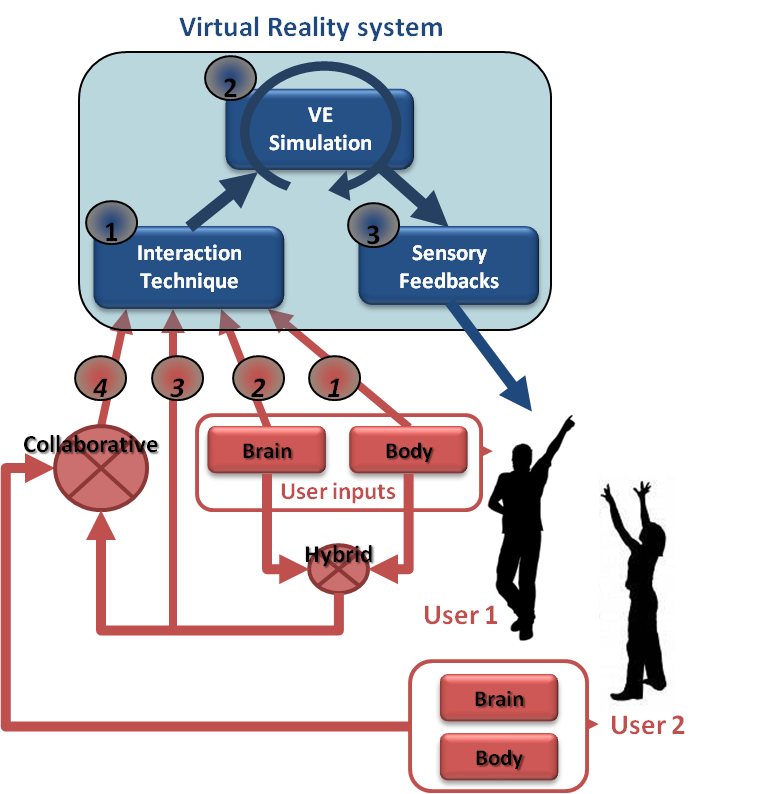Section: Research Program
Research Program
The scientific objective of Hybrid team is to improve 3D interaction of one or multiple users with virtual environments, by making full use of physical engagement of the body, and by incorporating the mental states by means of brain-computer interfaces. We intend to improve each component of this framework individually, but we also want to improve the subsequent combinations of these components.
|
The "hybrid" 3D interaction loop between one or multiple users and a virtual environment is depicted on Figure 1 . Different kinds of 3D interaction situations are distinguished (red arrows, bottom): 1) body-based interaction, 2) mind-based interaction, 3) hybrid and/or 4) collaborative interaction (with at least two users). In each case, three scientific challenges arise which correspond to the three successive steps of the 3D interaction loop (blue squares, top): 1) the 3D interaction technique, 2) the modeling and simulation of the 3D scenario, and 3) the design of appropriate sensory feedback.
The 3D interaction loop involves various possible inputs from the user(s) and different kinds of output (or sensory feedback) from the simulated environment. Each user can involve his/her body and mind by means of corporal and/or brain-computer interfaces. A hybrid 3D interaction technique (1) mixes mental and motor inputs and translates them into a command for the virtual environment. The real-time simulation (2) of the virtual environment is taking into account these commands to change and update the state of the virtual world and virtual objects. The state changes are sent back to the user and perceived by means of different sensory feedbacks (e.g., visual, haptic and/or auditory) (3). The sensory feedbacks are closing the 3D interaction loop. Other users can also interact with the virtual environment using the same procedure, and can eventually “collaborate” by means of “collaborative interactive techniques” (4).
This description is stressing three major challenges which correspond to three mandatory steps when designing 3D interaction with virtual environments:
-
3D interaction techniques: This first step consists in translating the actions or intentions of the user (inputs) into an explicit command for the virtual environment. In virtual reality, the classical tasks that require such kinds of user command were early categorized in four [58] : navigating the virtual world, selecting a virtual object, manipulating it, or controlling the application (entering text, activating options, etc). The addition of a third dimension, the use of stereoscopic rendering and the use of advanced VR interfaces make however inappropriate many techniques that proved efficient in 2D, and make it necessary to design specific interaction techniques and adapted tools. This challenge is here renewed by the various kinds of 3D interaction which are targeted. In our case, we consider various cases, with motor and/or cerebral inputs, and potentially multiple users.
-
Modeling and simulation of complex 3D scenarios: This second step corresponds to the update of the state of the virtual environment, in real-time, in response to all the potential commands or actions sent by the user. The complexity of the data and phenomena involved in 3D scenarios is constantly increasing. It corresponds for instance to the multiple states of the entities present in the simulation (rigid, articulated, deformable, fluids, which can constitute both the user’s virtual body and the different manipulated objects), and the multiple physical phenomena implied by natural human interactions (squeezing, breaking, melting, etc). The challenge consists here in modeling and simulating these complex 3D scenarios and meeting, at the same time, two strong constraints of virtual reality systems: performance (real-time and interactivity) and genericity (e.g., multi-resolution, multi-modal, multi-platform, etc).
-
Immersive sensory feedbacks: This third step corresponds to the display of the multiple sensory feedbacks (output) coming from the various VR interfaces. These feedbacks enable the user to perceive the changes occurring in the virtual environment. They are closing the 3D interaction loop, making the user immersed, and potentially generating a subsequent feeling of presence. Among the various VR interfaces which have been developed so far we can stress two kinds of sensory feedback: visual feedback (3D stereoscopic images using projection-based systems such as CAVE systems or Head Mounted Displays); and haptic feedback (related to the sense of touch and to tactile or force-feedback devices). The Hybrid team has a strong expertize in haptic feedback, and in the design of haptic and “pseudo-haptic” rendering [59] . Note that a major trend in the community, which is strongly supported by the Hybrid team, relates to a “perception-based” approach, which aims at designing sensory feedbacks which are well in line with human perceptual capacities.
These three scientific challenges are addressed differently according to the context and the user inputs involved. We propose to consider three different contexts, which correspond to the three different research axes of the Hybrid research team, namely : 1) body-based interaction (motor input only), 2) mind-based interaction (cerebral input only), and then 3) hybrid and collaborative interaction (i.e., the mixing of body and brain inputs from one or multiple users).



